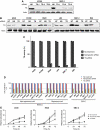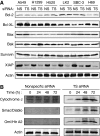Identification of thymidylate synthase as a potential therapeutic target for lung cancer
- PMID: 20628382
- PMCID: PMC2920030
- DOI: 10.1038/sj.bjc.6605793
Identification of thymidylate synthase as a potential therapeutic target for lung cancer
Retraction in
-
Retraction Note: Identification of thymidylate synthase as a potential therapeutic target for lung cancer.Br J Cancer. 2025 Nov;133(8):1231. doi: 10.1038/s41416-025-03211-1. Br J Cancer. 2025. PMID: 40973719 Free PMC article. No abstract available.
Abstract
Background: Thymidylate synthase (TS), a key enzyme in the de novo synthesis of thymidine, is an important chemotherapeutic target for malignant tumours including lung cancer. Although inhibition of TS has an antiproliferative effect in cancer cells, the precise mechanism of this effect has remained unclear.
Methods: We examined the effects of TS inhibition with an RNA interference-based approach. The effect of TS depletion on the growth of lung cancer cells was examined using colorimetric assay and flow cytometry.
Results: Measurement of the enzymatic activity of TS in 30 human lung cancer cell lines revealed that such activity differs among tumour histotypes. Almost complete elimination of TS activity by RNA interference resulted in inhibition of cell proliferation in all tested cell lines, suggestive of a pivotal role for TS in cell proliferation independent of the original level of enzyme activity. The antiproliferative effect of TS depletion was accompanied by arrest of cells in S phase of the cell cycle and the induction of caspase-dependent apoptosis as well as by changes in the expression levels of cyclin E and c-Myc. Moreover, TS depletion induced downregulation of the antiapoptotic protein X-linked inhibitor of apoptosis (XIAP), and it seemed to activate the mitochondrial pathway of apoptosis.
Conclusion: Our data provide insight into the biological relevance of TS as well as a basis for clinical development of TS-targeted therapy for lung cancer.
Figures





References
-
- Allen J, Jahanzeb M (2008) Extensive-stage small-cell lung cancer: evolution of systemic therapy and future directions. Clin Lung Cancer 9: 262–270 - PubMed
-
- Asamura H, Goya T, Koshiishi Y, Sohara Y, Eguchi K, Mori M, Nakanishi Y, Tsuchiya R, Shimokata K, Inoue H, Nukiwa T, Miyaoka E (2008) A Japanese Lung Cancer Registry study: prognosis of 13,010 resected lung cancers. J Thorac Oncol 3: 46–52 - PubMed
-
- Bhattacharjee A, Richards WG, Staunton J, Li C, Monti S, Vasa P, Ladd C, Beheshti J, Bueno R, Gillette M, Loda M, Weber G, Mark EJ, Lander ES, Wong W, Johnson BE, Golub TR, Sugarbaker DJ, Meyerson M (2001) Classification of human lung carcinomas by mRNA expression profiling reveals distinct adenocarcinoma subclasses. Proc Natl Acad Sci USA 98: 13790–13795 - PMC - PubMed
-
- Bunz F, Dutriaux A, Lengauer C, Waldman T, Zhou S, Brown JP, Sedivy JM, Kinzler KW, Vogelstein B (1998) Requirement for p53 and p21 to sustain G2 arrest after DNA damage. Science 282: 1497–1501 - PubMed
-
- Burma S, Chen BP, Murphy M, Kurimasa A, Chen DJ (2001) ATM phosphorylates histone H2AX in response to DNA double-strand breaks. J Biol Chem 276: 42462–42467 - PubMed
Publication types
MeSH terms
Substances
LinkOut - more resources
Full Text Sources
Other Literature Sources
Medical
Research Materials

